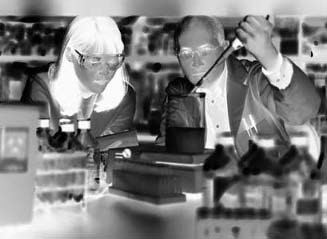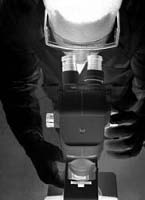are based upon the conviction that there is
should use in the classroom.
much to be gained by involving students
• At the beginning of the school year,
in analyzing issues of science, technology,
establish consequences for students who
and society. Society expects all citizens to
behave in an unsafe manner. Make these
participate in the democratic process, and our
consequences clear to students.
educational system must provide opportunities
• Do not overlook any violation of a safety
for students to learn to deal with contentious
practice, no matter how minor. If a rule
issues with civility, objectivity, and fairness.
is broken, take steps to assure that the
Likewise, students need to learn that science
infraction will not occur a second time.
intersects with life in many ways.
• Set a good example by observing all safety
practices. This includes wearing eye
In this module, students are given a variety of
protection during all investigations when
opportunities to discuss, interpret, and evaluate
eye protection is required for students.
basic science and health issues, some in light of
• Know and follow waste disposal
their values and ethics. As students encounter
regulations.
issues about which they feel strongly, some
• Be aware of students who have allergies or
discussions might become controversial. The
other medical conditions that might limit
degree of controversy depends on many factors,
their ability to participate in activities.
such as how similar students are with respect
Consult with the school nurse or school
to socioeconomic status, perspectives, value
administrator.
systems, and religious beliefs. In addition, your
• Anticipate potential problems. When
language and attitude influence the flow of
planning teacher demonstrations or student
ideas and the quality of exchange among the
investigations, identify potential hazards
students.
and safety concerns. Be aware of what
could go wrong and what can be done to
The following guidelines may help you
prevent the worst-case scenario. Before each
facilitate discussions that balance factual
activity, verbally alert the students to the
information with feelings:
potential hazards and distribute specific
• Remain neutral. Neutrality may be the
safety instructions as well.
single most important characteristic of a
• Supervise students at all times during
successful discussion facilitator.
hands-on activities.
• Encourage students to discover as much
information about the issue as possible.
11
Implementing the Module
Doing Science: The Process of Scientific Inquiry
• Keep the discussion relevant and moving
• Create a sense of freedom in the classroom.
forward by questioning or posing
Remind students, however, that freedom
appropriate problems or hypothetical
implies the responsibility to exercise that
situations. Encourage everyone to
freedom in ways that generate positive
contribute, but do not force reluctant
results for all.
students to enter the discussion.
• Insist upon a nonhostile environment in
• Emphasize that everyone must be open to
the classroom. Remind students to respond
hearing and considering diverse views.
to ideas instead of to the individuals
• Use unbiased questioning to help students
presenting those ideas.
critically examine all views presented.
• Respect silence. Reflective discussions are
• Allow for the discussion of all feelings and
often slow. If a teacher breaks the silence,
opinions.
students may allow the teacher to dominate
• Avoid seeking consensus on all issues.
the discussion.
Discussing multifaceted issues should
• At the end of the discussion, ask students
result in the presentation of divergent
to summarize the points made. Respect
views, and students should learn that this
students regardless of their opinions about
is acceptable.
any controversial issue.
• Acknowledge all contributions in the same
evenhanded manner. If a student seems to
be saying something for its shock value,
see whether other students recognize the
inappropriate comment and invite them
to respond.
12
Using the Student Lessons
The heart of this module is the set of four
• Web-Based Activities indicates which of
classroom lessons. These lessons are the
the lesson’s activities use the Doing Science:
vehicles that will carry important concepts
The Process of Scientific Inquiry Web site as
related to scientific inquiry to your students.
the basis for instruction.
To review the concepts in detail, refer to the
• Photocopies lists the paper copies and
Science Content and Conceptual Flow of the
transparencies that need to be made from
Lessons table, on page 000.
masters, which follow Lesson 4, at the end
of the module.
Format of the Lessons
• Materials lists all the materials (other
As you review the lessons, you will find that all
than photocopies) needed for each of the
contain common major features.
activities in the lesson.
• Preparation outlines what you need to do
At a Glance provides a convenient summary of
to be ready to teach the lesson.
the lesson.
• Overview provides a short summary of
Procedure outlines the steps in each activity
student activities.
of the lesson. It includes implementation hints
• Major Concepts states the central ideas the
and answers to discussion questions.
lesson is designed to convey.
• Objectives lists specific understandings
Within the Procedure section, annotations,
or abilities students should have after
with accompanying icons, provide additional
completing the lesson.
commentary:
• Teacher Background specifies which
portions of the background section,
identifies teaching strategies that
Information about the Process of Scientific
address specific science content
Inquiry, relate directly to the lesson. This
standards as defined by the National
reading material provides the science
Science Education Standards.
content that underlies the key concepts
covered in the lesson. The information
identifies when to use the Web site
provided is not intended to form the basis
as part of the teaching strategy.
of lectures to students. Instead, it enhances
Instructions tell you how to access
your understanding of the content so that
the Web site and the relevant
you can more accurately facilitate class
activity. Information about using
discussions, answer student questions, and
the Web site can be found in Using the Web
provide additional examples.
Site (see page 15). A print-based alternative to
Web activities is provided for classrooms in
In Advance provides instructions for collecting
which Internet access is not available.
and preparing the materials required to
complete the activities in the lesson.
13
Doing Science: The Process of Scientific Inquiry
identifies suggestions from field-
The lesson organizer is a memory aid you can
test teachers for teaching strategies,
use after you are familiar with the detailed
class management, and module
procedures of the activities. It can be a handy
implementation.
resource during lesson preparation as well as
during classroom instruction.
identifies a print-based alternative
to a Web-based activity to be used
Masters required to teach the activities are
when computers are not available.
located after Lesson 4, at the end of the
module.
identifies when assessment is
embedded in the module’s structure.
Timeline for the Module
An annotation suggests strategies
The following timeline outlines the optimal
for assessment.
plan for completing the four lessons in this
module. This plan assumes that you will teach
The Lesson Organizer provides a brief
the activities on consecutive days. If your class
summary of the lesson. It outlines procedural
requires more time for completing the activities
steps for each activity and includes icons
or for discussing issues raised in this module,
that denote where in each activity masters,
adjust your timeline accordingly.
transparencies, and the Web site are used.
Suggested Timeline
Timeline
Activity
3 weeks ahead
Reserve computers and verify Internet access.
1 week ahead
Copy masters, make transparencies, gather materials.
Lesson 1
Day 1
Activity 1: Mystery Cube
Monday
Activity 2: The Biological Box
Activity 3: Thinking about Inquiry
Lesson 2
Day 2
Activity 1: What’s the Question?
Tuesday
Activity 2: Questions … More Questions
Day 3
Lesson 3
Wednesday
Activity 1: Unusual Absences
Day 4
Lesson 3
Thursday
Activity 2: What’s the Cause?
Day 5
Lesson 3
Friday
Activity 3: What’s the Source?
Day 6
Lesson 3
Monday
Activity 4: Reflecting on the Process of Scientific Inquiry
Day 7
Lesson 4
Tuesday
Activity 1: Pulling It All Together
14
Using the Web Site
The Doing Science: The Process of Scientific
Getting the Most out of the Web Site
Inquiry Web site is a wonderful tool that
Before you use the Web site, or any other piece
can engage student interest in learning, and
of instructional technology in your classroom,
orchestrate and individualize instruction. The
it is valuable to identify the benefits you expect
Web site features simulations that articulate
the technology to provide. Well-designed
with two of the supplement’s lessons. To access
instructional multimedia software can
the Web site, type the following URL into your
• motivate students by helping them enjoy
browser: http://science.education.nih.gov/
learning—students want to learn more
supplements/inquiry/teacher. Click on the link
when content that might otherwise be
to a specific lesson under Web Portion of
uninteresting is enlivened;
Student Activities.
• offer unique instructional capabilities that
allow students to explore topics in greater
Hardware/Software Requirements
depth—technology offers experiences that
The Web site can be accessed from Apple
are closer to actual life than print-based
Macintosh and IBM-compatible personal
media offer;
computers. The recommended hardware and
• support teachers in experimenting with
software requirements for using the Web site
new instructional approaches that allow
are listed in the following table. Although your
students to work independently or in small
computer configuration may differ from those
teams—technology gives teachers increased
listed, the Web site may still be functional on
credibility among today’s technology-
your computer. The most important item in
literate students; and
this list is the browser.
Recommended Hardware and Software Requirements for Using the Web Site*
CPU/processor (PC Intel, Mac)
Pentium III, 600 MHz; or Mac G4
Operating system (DOS/Windows, Mac OS)
Windows 2000 or higher; or Mac OS 9 or newer
System memory (RAM)
256 MB or more
Screen setting
1024 × 768 pixels, 32 bit color
Microsoft Internet Explorer 6.0 or
Browser
Netscape Communicator 7.1
Browser settings
JavaScript enabled
Free hard-drive space
10 MB
Connection speed
High speed (cable, DSL, or T1)
*For users of screen-reader software, a multichannel sound card such as Sound Blaster® Live!™ is recommended.
15
Doing Science: The Process of Scientific Inquiry
• increase teacher productivity—technology
We recommend that you keep your students
helps teachers with assessment, record
in the same collaborative teams for all the
keeping, and classroom planning and
activities in the lessons. This will allow each
management.
team to develop a shared experience with the
Web site and with the ideas and issues that
Ideal use of the Web site requires one computer
the activities present. A shared experience
for each student team. However, if you have
will enhance your students’ perceptions of the
only one computer available in the classroom,
lessons as a conceptual whole.
you can still use the Web site. For example,
you can use a projection system to display
If your student-to-computer ratio is greater
the monitor image for the whole class to
than four to one, you will need to change
see. Giving selected students in the class the
the way you teach the module from the
opportunity to manipulate the Web activities
instructions in the lessons. For example, if
in response to suggestions from the class can
you have only one computer available, you
give students some of the same autonomy in
may want students to complete the Web-based
their learning that they can gain from working
work over an extended time period. You can
in small teams. Alternatively, you can rotate
do this in several ways. The most practical
student teams through the single computer
way is to use your computer as a center along
station. If you do not have the facilities for
with several other centers at which students
using the Web site with your students, you can
complete other activities. In this approach,
use the print-based alternatives provided for
students rotate through the computer center,
the Lesson 3 and 4 activities.
eventually completing the Web-based work that
you have assigned.
Collaborative Groups
We designed many of the activities to be
A second way to structure the lessons if you
done by teams of students working together.
have only one computer available is to use a
Although individual students working alone
projection system to display the desktop
can complete the activities, this strategy
screen for the whole class to view. Giving
does not stimulate the types of student-
selected students in the class the opportunity
student interactions that are part of active,
to manipulate the Web activities in response
collaborative, inquiry-based learning.
to suggestions from the class can give students
Therefore, we recommend that you organize
some of the same autonomy in their learning
collaborative teams of two to four students
they would have gained from working in
each, depending on the number of computers
small teams.
available. Students in groups larger than four
often have difficulty organizing the student-
Web Activities for Students with
computer interactions equitably, leading
Disabilities
to one or two students assuming primary
The Office of Science Education (OSE) is
responsibility for the computer-based work.
committed to providing access to the
Although large groups can be efficient, they
Curriculum Supplement Series for individuals
do not allow all the students to experience the
with disabilities, including members of
in-depth discovery and analysis that the Web
the public and federal employees. To meet
site was designed to stimulate. Team members
this commitment, we will comply with
not involved directly may become bored or
the requirements of Section 508 of the
disinterested.
Rehabilitation Act. Section 508 requires that
individuals with disabilities who are members
16
of the public seeking these materials will have
of the problem, the format in which you
access to and use of information and data that
would like to receive the material, the Web
are comparable to those provided to members
address of the requested material, and your
of the public who are not individuals with
contact information.
disabilities. The online versions of this series
have been prepared to comply with Section 508.
Contact us at
Curriculum
Supplement
Series
If you use assistive technology (such as a Braille
Office of Science Education
reader or a screen reader) and the format of any
National Institutes of Health
materials on our Web site interferes with your
6705 Rockledge Drive, Suite 700 MSC 7984
ability to access the information, please let us
Bethesda,
MD
20892-7984
know. To enable us to respond in a manner
supplements@science.education.nih.gov
most helpful to you, please indicate the nature
Doing Science: The Process of Scientific Inquiry 508-Compliant Web Activities For students with hearing
Lesson, activity
For students with sight impairment
impairment
Lesson 3,
No special considerations are
Students using screen-magnification or
Activities 1, 2, and 3
required.
screen-reading software can choose an
alternate, text-based version of the activity.
The content of the two versions of the
activity is equivalent.
The “Progress Map” at the bottom of each
page keeps track of the student’s progress.
If the student closes the activity and returns
to it later, the activity will resume where the
student left it. The last page of the activity
provides a summary of all the student’s
answers. The student can use the Progress
Map to return to any page and edit his or
her responses.
The computer the students use must be
connected to the Internet.
Supervision is recommended.
Lesson 4,
No special considerations are
Same as Lesson 3, Activities 1, 2, and 3.
Activity 1
required.
17
Using the Web Site



Information about the
Process of Scientific Inquiry
1 Introduction
To a scientist, inquiry refers to an intellectual
“Scientifi c Inquiry refers to the diverse ways in
process that humans have practiced for
which scientists study the natural world and pro-
thousands of years. However, the history of
pose explanations based on the evidence derived
inquiry in American science education is much
briefer. Until about 1900, science education
from their work. Inquiry also refers to the activi-
was regarded as getting students to memorize
ties of students in which they develop knowledge
a collection of facts. In fact, many of today’s
and understanding of scientifi c ideas, as well
teachers and students can confirm that this
as an understanding of how scientists study the
approach is still with us. In 1910, John Dewey
natural world.”
criticized this state of affairs in science
—National Research Council9
education.11 He argued that science should be
taught as a way of thinking. According to this
view, science should be taught as a process.
During the 1950s and 1960s, educator Joseph
Schwab observed that science was being driven
by a new vision of scientific inquiry.12 In
Schwab’s view, science was no longer a process
for revealing stable truths about the world, but
instead it reflected a flexible process of inquiry.
He characterized inquiry as either “stable” or
“fluid.” Stable in






